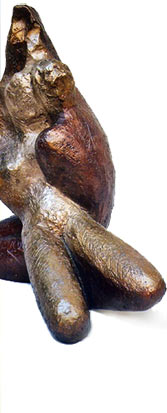|
Today's and yesterday's sculptures
Why has sculpture been disposed of, today ? As a matter of fact, there is not lack of beauties nowadays, women beauties in particular, but their being conveyed in stone or bronze has almost gone out. The party definitely came to a close a long time ago as far as the walls and fountains of Paris are concerned, and yesterday’s beautiful statuary has now become but museum items. I often enviously imagine what emulation must have been reigning a century ago, when hundreds of sculptors and stonecutters were embellishing Paris !
When I, haunted by great sculptural periods, walk round and round in my studio, I feel disheartened, filled with the hard-to-bear impression that a wide river flow came to a stop … It urges me to take up the gesture pertaining to sculpture, and I then invent the themes of my days, maybe as a water-diviner that would bring water back where it once flooded –for why should the rivulet of sculpture not know better days again ? That very jocundity of hand that came to us from the heart of Prehistoric ages will not become extinct so easily.
Thus do I revert to my studio, and there do I work at my lonely, little bit of a humble work … Maybe, my modernity consists in indulging in my likings and what attracts me, i.e. the happy forms of basic human nature : unity/duality man/woman; doing so, I simply serve some of the deepest expectations of our times, among the most discreet and private ones, as well as what is in search of itself and yearns for sturdy loves. All such things –happiness life cannot do without- that have been poorly and little existing until the 1965ies, in particular in the case of women. And is not that quest one of the deepest and most positive hint at the rising of western modernity, and, paradoxically, what is most complying with sculpture, hence most promising for the renewal of sculpture ?
The 20th century plastic arts got more and more committed to images (painting, photography …) at the expense of sculpture –a trend a sculptor would term an easier alternative -all based on effects- and even, in cases, superficiality. They did so while the men and women of that century were getting rid of the noxious aspects of their Christian legacy (about body, woman, sexuality …) and trying to find better landmarks, thus setting higher standards and making themselves naturally more responsive to –and heedful of- the testimony sculpture could bear on their corporeality, their sensitive intimacy, their strength and their happiness.
(Translated by Michèle Bustros)
|
 |
THE BIRTH OF VENUS
THE FIRE
THE SWEET ALMOND
Landowski 03
|
 |
|